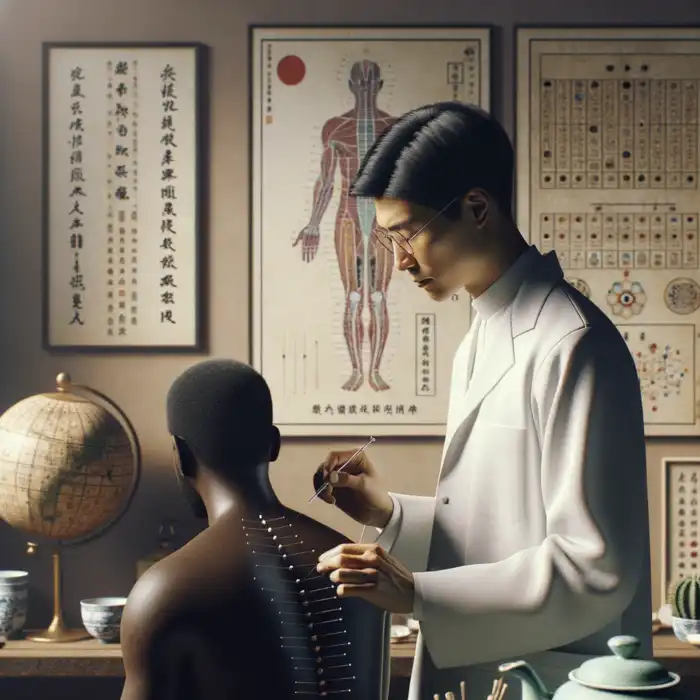Cultural Perspectives on Acupuncture Practices

Posted on: 2025-03-14
By: Kaiya Whitmore
Did You Know Acupuncture is a Global Phenomenon?
Did you know that acupuncture, a practice rooted in ancient Chinese medicine, has evolved into a global phenomenon, adapting to different cultures and health systems? This evolution reveals not only the resilience of acupuncture but also its capacity to enhance well-being across various societies. Let's explore the key insights that showcase how acupuncture transcends borders and enriches health practices worldwide.
What You Will Learn
- Acupuncture is based on the concept of Qi, the vital life force essential for health and balance.
- Real-life case studies highlight the cultural adaptations and effectiveness of acupuncture across different settings.
- Each culture that adopts acupuncture enriches its practice by incorporating local traditions and health beliefs.
- Modern acupuncture applications focus on pain management, emotional well-being, and holistic healing, validating its relevance in today’s healthcare landscape.
Key Insights on Acupuncture's Cultural Adoption
Acupuncture has evolved significantly, adapting to various cultures around the world. Below are some key points highlighting its origins, adaptations, and modern applications.
Origin
Started in ancient China over 2,500 years ago, rooted in philosophies like Yin and Yang.
Adaptation
Each country tailored the practices to fit local health customs and beliefs, showcasing unique techniques.
Integration
Acupuncture has been integrated into various healthcare systems worldwide, enhancing holistic practices.
Modern Applications
Incorporated into integrative medicine for pain management and holistic healing, addressing both physical and emotional health.
Understanding Global Acupuncture Practices Across Cultures
Acupuncture is more than just a therapy; it’s a bridge between ancient traditions and modern wellness. At its core, acupuncture involves the insertion of thin needles into specific points of the body to restore balance and promote healing. This practice, rooted in Chinese medicine, has evolved significantly, adapting to various cultures around the world. Have you ever thought about how this ancient art translates into different health practices globally? It's fascinating to see how cultures embrace acupuncture, offering unique perspectives and techniques!
Defining Acupuncture and Its Significance
To truly appreciate acupuncture, we need to understand its underlying principles. This ancient practice is based on the concept of Qi (pronounced "chee"), which refers to the vital life force that flows through our bodies. When Qi is balanced, we experience good health; when it's disrupted, illness can occur. Acupuncture aims to restore this balance, making it a vital tool in holistic health approaches.
Moreover, acupuncture is significant for its role in pain management and emotional well-being. In a world where stress and chronic pain are common, acupuncture provides a natural alternative. As an acupuncturist with a decade of experience, I’ve seen firsthand how patients like Maya, who struggled with migraines, have found relief and improved quality of life through this practice. It’s a powerful reminder of the potential benefits acupuncture offers! For more insights on acupuncture benefits, read our article: Insights on Acupuncture Benefits.
Primary Search Intent: Why Case Studies Matter
When exploring global acupuncture practices, case studies are invaluable. They provide real-life examples of how acupuncture is applied across different settings, reflecting cultural adaptations and innovations. By examining these cases, we gain insights into the effectiveness of acupuncture and how it meets the needs of diverse populations.
- Case studies highlight unique adaptations of acupuncture techniques.
- They showcase the transformative power of acupuncture on individual health journeys.
- These examples foster a deeper understanding of acupuncture's role in various healthcare systems.
- They encourage dialogue and exchange of ideas among practitioners and enthusiasts.
At Acupuncture Perspectives, I believe that sharing these stories not only promotes awareness but also inspires a sense of community. Each case study reflects the commitment to holistic health and the ongoing evolution of acupuncture. By diving into these narratives, we can appreciate acupuncture not just as a treatment, but as a worldwide movement towards well-being.
The Cultural Adoption and Historical Migration of Acupuncture
Acupuncture has traveled far from its origins, influenced by historical migrations and cultural exchanges. Understanding this journey enriches our appreciation of its global significance. Have you ever wondered how traditional practices adapt as they cross borders? Let’s explore the fascinating history of acupuncture’s migration and its cultural adaptations!
Quick Summary
Here's a brief recap of the key points discussed so far:
- Acupuncture is a holistic therapy rooted in Chinese medicine that restores balance through the insertion of needles at specific body points.
- The concept of Qi is fundamental to acupuncture, emphasizing the importance of balance for good health and well-being.
- Case studies highlight how acupuncture adapts across cultures, showcasing unique practices and the transformative impact on individual health.
- Acupuncture's historical journey reflects its integration into various healthcare systems, enriching local traditions and health customs.
Summarizing Key Insights from Global Acupuncture Case Studies
As we wrap up our exploration of acupuncture's diverse practices around the globe, it's essential to reflect on the major insights gathered from various case studies. Each culture has adopted acupuncture in unique ways, enriching not only their health practices but also their understanding of holistic wellness. These insights highlight the importance of cultural context in shaping how acupuncture is perceived and utilized.
Acupuncture's origins in Chinese medicine serve as a foundation, but its journey through countries like Cuba, Guatemala, and the Philippines reveals how local traditions and health systems have molded its applications. This cultural adoption signifies that acupuncture is not merely a set of techniques; it embodies the values and beliefs of each society. Each case study we've explored illustrates this remarkable flexibility and adaptability. To learn more about global acupuncture practices, you might find our article on Global Acupuncture Practices Uncovered insightful.
Recap of Cultural Adoption and Historical Significance
The historical significance of acupuncture cannot be overstated. It started in China over 2,500 years ago and has since traveled far and wide. Here's a quick recap of the key points regarding its cultural adoption:
- Origin: Began in ancient China, deeply rooted in philosophies like Yin and Yang.
- Adaptation: Each country tailored the practices to fit local health customs and beliefs.
- Integration: Acupuncture has been integrated into various healthcare systems, from Cuba's community clinics to Guatemala's health initiatives.
These points emphasize how acupuncture has not only survived but thrived, adapting to the needs and values of different populations. At Acupuncture Perspectives, we celebrate this rich history and the ongoing evolution of acupuncture practices.
Highlights of Modern Applications and Benefits
Today's use of acupuncture reflects a blend of traditional principles and modern medical practices. Its effectiveness in managing pain and promoting overall wellness continues to be validated by both practitioners and patients. Here are some highlights regarding its modern applications:
- Pain Management: Acupuncture is increasingly recognized for its role in chronic pain relief, whether it be headaches, back pain, or arthritis.
- Integrative Medicine: Many healthcare providers are incorporating acupuncture into integrative medicine practices, combining it with conventional treatments. For a deeper understanding of acupuncture's role in Western medicine, check out this article: Acupuncture's Role in Western Medicine.
- Holistic Healing: Acupuncture promotes a holistic approach to wellness, addressing both physical and emotional health.
These modern applications show how acupuncture remains relevant and beneficial in today's health landscape. As an advocate for holistic health, I find it inspiring to see acupuncture evolving while retaining its core principles.
Engaging with Global Acupuncture Communities
Now that we’ve explored the insights and benefits of acupuncture from around the world, I want to invite you to dive deeper into this fascinating subject. There are numerous resources available if you want to learn more about specific techniques or cultural practices. Below are some helpful resources to consider:
- Books: Look for texts that delve into the history and theory of acupuncture.
- Online Courses: Many institutions offer courses on acupuncture techniques and their application.
- Community Events: Join local acupuncture workshops or health fairs to connect with practitioners.
By engaging with these resources, you can broaden your understanding and appreciation for this ancient practice. And I’d love to hear from you! Have you ever tried acupuncture? What was your experience like? Sharing stories not only fosters a sense of community but allows all of us to learn from one another's journeys. Let’s continue the conversation about the transformative power of acupuncture together! For a better understanding of Acupuncture and Chinese Medicine, please refer to: Understanding Acupuncture and Chinese Medicine.
Recap of Key Points
Here is a quick recap of the important points discussed in the article:
- Understanding Acupuncture: Acupuncture restores balance by targeting Qi, the vital life force, and is significant in pain management and emotional well-being.
- Importance of Case Studies: Case studies provide insights into the cultural adaptations and effectiveness of acupuncture across different populations.
- Cultural Journey: Acupuncture has evolved from its origins in China, integrating local customs and health practices in countries like Cuba and Guatemala.
- Modern Applications: Acupuncture is recognized for chronic pain relief and is increasingly incorporated into integrative medicine, promoting holistic healing.
- Community Engagement: Resources such as books, online courses, and community events can deepen your understanding and appreciation of acupuncture.
Frequently Asked Questions (FAQs)
Q: What is acupuncture based on?
A: Acupuncture is based on the principle of Qi, the body's vital life force. Restoring balance to this energy flow is central to the practice.
Q: Why are case studies important in understanding global acupuncture?
A: Case studies demonstrate the real-world effectiveness and cultural adaptations of acupuncture across diverse populations.
Q: How has acupuncture evolved culturally?
A: Acupuncture, originating in China, has adapted to various cultural contexts, integrating local traditions and beliefs worldwide.
Q: What are some modern applications of acupuncture?
A: Modern acupuncture is used for pain management, as part of integrative medicine, and to promote overall holistic healing.
Q: How can I learn more about global acupuncture practices?
A: Explore books, online courses, and local community events to deepen your understanding.
 Acupuncture, an ancient practice with roots in Traditional Chinese Medicine, has transcended cultura
Acupuncture, an ancient practice with roots in Traditional Chinese Medicine, has transcended cultura
 As the demand for alternative therapies grows, the need for well-trained acupuncturists becomes para
As the demand for alternative therapies grows, the need for well-trained acupuncturists becomes para
 As global health trends evolve, ancient practices like acupuncture are finding their place in modern
As global health trends evolve, ancient practices like acupuncture are finding their place in modern